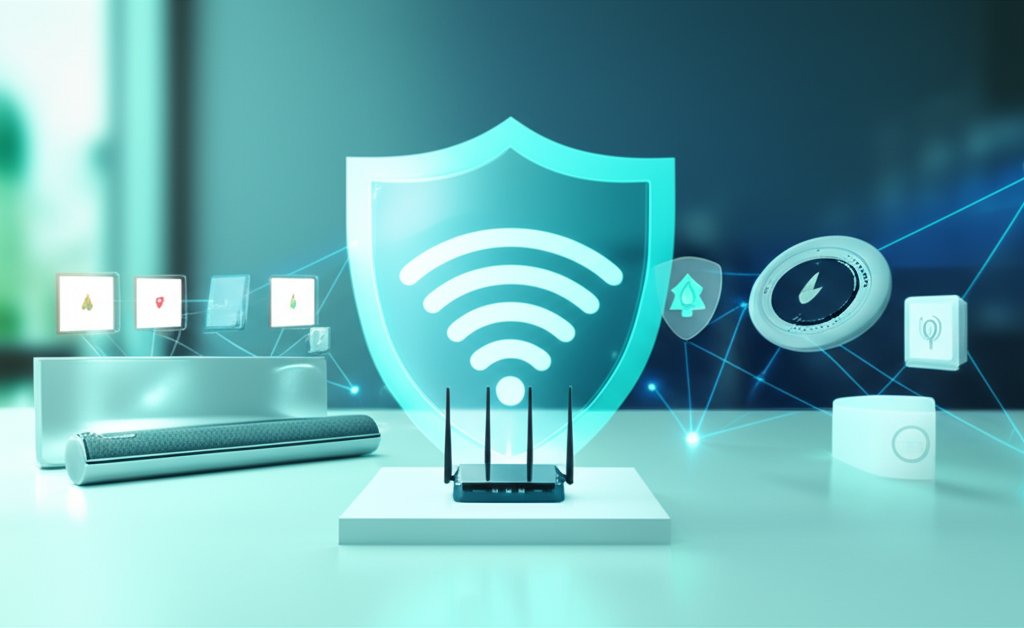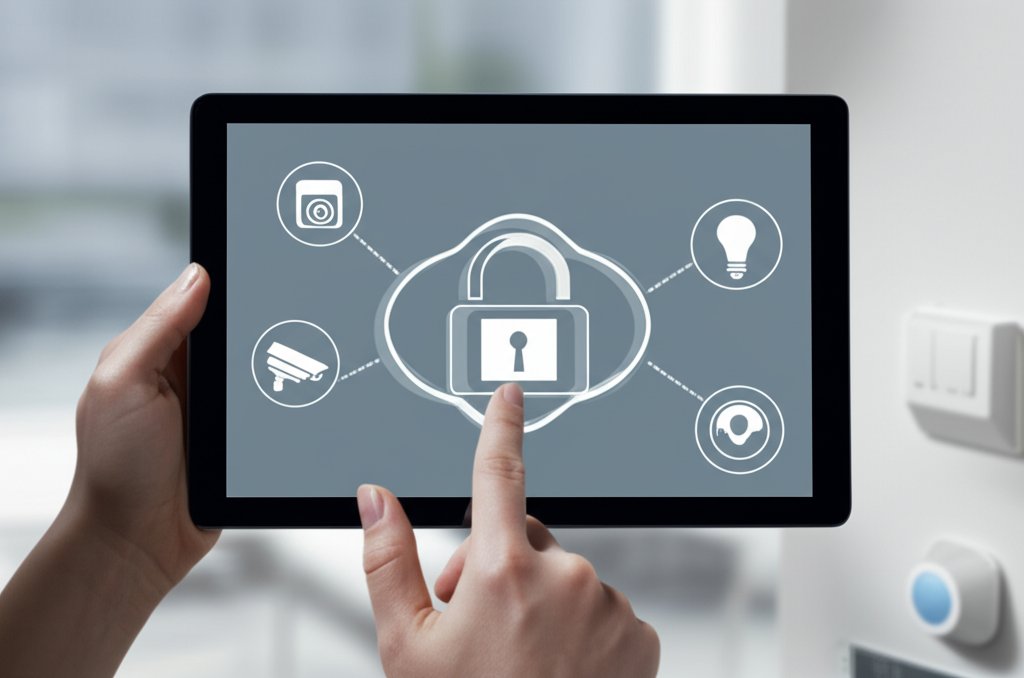Why Your Smart Home Needs a Cybersecurity Checkup (And How to Do It Easily)
Your smart home is a hub of convenience, anticipating your needs and simplifying your daily life. From voice assistants that manage our schedules to thermostats that learn our preferences, the smart home has undoubtedly streamlined our lives. But as a security professional, I’ve seen firsthand how this increased connectivity also brings increased vulnerability. Every connected device, from your smart doorbell to your smart light bulbs, represents a potential entry point for cyber threats. We’ll explore why your smart home needs a dedicated cybersecurity checkup and, crucially, how you can perform one easily. Don’t worry if you’re not tech-savvy; these are practical, actionable steps anyone can follow to safeguard their digital sanctuary.
The Rise of the Smart Home: Convenience Meets Connectivity
In our modern world, smart home technology has moved from futuristic fantasy to everyday reality. We’re talking about devices that automate tasks, improve energy efficiency, and keep us connected to our homes even when we’re miles away. It’s fantastic, isn’t it? The sheer convenience is undeniable. However, this web of interconnected devices – often referred to as the Internet of Things (IoT) – introduces a complex landscape where convenience directly correlates with increased potential for vulnerability. Every gadget you add, from a smart fridge to a Wi-Fi enabled coffee maker, becomes another node in your personal digital ecosystem, and frankly, another potential target for cyber threats.
For everyday internet users like you and me, understanding these risks and knowing how to protect ourselves isn’t just for tech experts. It’s about protecting your privacy, your data, and even your physical safety. So, let’s dive into what might be lurking in your connected home.
What’s Hiding in Your Connected Home? Common Smart Home Cybersecurity Risks
When we talk about smart home security, we’re not just discussing abstract computer problems. We’re talking about real risks that can affect your personal life. What could possibly go wrong, you ask? A lot, unfortunately, if you’re not proactive. Here are the common threats we often see:
Data & Privacy Breaches
Many smart devices are designed to collect data – it’s how they learn and provide convenience. Think about it: your smart speaker records voice commands, your security camera captures video feeds, your fitness tracker monitors your health, and your smart thermostat tracks your home occupancy. This data, which often includes highly sensitive personal information, can become a goldmine for cybercriminals. If a device or its associated cloud service is compromised, your voice recordings could be used to build a profile, your video feeds could be spied on, or your location data could expose your routines. This isn’t just about identity theft; it’s about losing control over your personal narrative and facing potential fraudulent transactions or even blackmail.
Device Hijacking & Remote Control
Imagine your smart lock unlocking itself, your thermostat cranking to an extreme temperature, or your security camera turning to spy on you instead of protecting you. This isn’t science fiction; it’s a very real threat called device hijacking. Hackers can exploit vulnerabilities to take control of your smart devices, using them for malicious purposes. Sometimes, they might even use your compromised devices as part of a larger “botnet” – a network of hijacked devices used to launch massive cyberattacks (like DDoS attacks) against websites or online services. Your smart light bulb could unwittingly be participating in an attack on a major bank, all without you ever knowing!
Network Compromise
One of the most insidious risks is how a single vulnerable smart device can act as a Trojan horse. If an attacker gains access to one weak point – perhaps a smart plug with a default password – they might not stop there. This compromised device can become a gateway, allowing them to infiltrate your entire home network. Once inside, they could potentially access other, more sensitive devices like your personal computers, smartphones, or network-attached storage. This dramatically increases the risk of malware spreading, ransomware encrypting your precious files, or sensitive financial information being stolen. It’s a chain reaction you absolutely want to avoid.
Physical Safety Risks
Beyond digital data, compromised smart devices can pose direct physical risks. A smart lock that’s been hacked could allow unauthorized entry into your home. Manipulated smart thermostats or smoke detectors could create unsafe living conditions or even delay emergency responses. While rare, these scenarios underscore the real-world consequences of neglecting smart home security. Your physical safety, not just your digital privacy, is at stake.
Time for a Smart Home Cybersecurity Checkup: Your Step-by-Step Guide
Feeling a bit overwhelmed? Don’t be! Performing a smart home cybersecurity checkup isn’t as daunting as it sounds, and it’s something every homeowner should do regularly. Think of it like a regular health check-up for your digital life – crucial for peace of mind. It’s about taking actionable steps and best practices to secure your smart home devices and network, and the good news is that many of these are surprisingly simple. Let’s walk through it together.
Step 1: Inventory Your Smart Devices (The First Line of Defense)
You can’t protect what you don’t know you own. Your very first, and perhaps most crucial, step is to gain a clear understanding of your digital landscape. This means creating a comprehensive inventory of every smart device connected to your home network.
Action: Create a Detailed Device List.
- Grab a pen and paper, or open a digital document. Walk through your home, room by room, and list every single smart device. Don’t forget the less obvious ones! Consider:
- Smart speakers (e.g., Amazon Echo, Google Home)
- Smart displays, TVs, and streaming devices
- Smart doorbells, security cameras, and baby monitors
- Smart thermostats and environmental sensors
- Smart light bulbs, switches, and plugs
- Robot vacuums and smart appliances (e.g., refrigerators, ovens)
- Any other device that connects to your Wi-Fi or a smart home hub.
- For each device, note down:
- Device Type: e.g., “Living Room Smart Speaker”
- Manufacturer and Model: e.g., “Ring Doorbell Pro 2,” “Philips Hue Bulb E27”
- Associated App/Account: e.g., “Ring app,” “Philips Hue app,” “Alexa account”
- Data Collected: What kind of information does it gather? (e.g., video, audio, location, motion, energy usage)
Action: Declutter and Disconnect.
With your inventory complete, critically evaluate each item. Are there any old smart plugs, cameras, or sensors you’re no longer using? Any devices gathering dust in a drawer but still configured on your network? If a device is not in active use, disconnect it from your Wi-Fi network and, if possible, physically unplug it. Every unused, forgotten device represents a potential, unmonitored entry point for cyber threats. Less is often more when it comes to security.
Step 2: Fortify Your Wi-Fi Network (The Digital Gateway to Your Home)
Think of your Wi-Fi network as the main entrance to your digital home. If this gateway is weak, even the most secure individual smart device is at risk. Here’s how to build a robust defense:
- Immediately Change Default Router Credentials:
- Why: Routers come with default usernames (e.g., “admin”) and passwords (e.g., “password,” “1234”) that are widely known and easily found online. Leaving them unchanged is an open invitation for attackers to gain full control of your network.
- How:
- Find your router’s IP address (often on a sticker on the router, or search “what is my router’s IP address” online).
- Type the IP address into your web browser.
- Enter the default username and password (again, often on a sticker or in the manual).
- Navigate to the “Administration,” “Security,” or “Settings” section and change both the username and password to something strong, unique, and complex. This isn’t your Wi-Fi password, but the credentials to access your router’s critical settings.
- Enable Strong Wi-Fi Encryption (WPA2/WPA3):
- Why: Encryption scrambles the data travelling over your Wi-Fi, making it unreadable to unauthorized parties. Older encryption types (like WEP or WPA) are easily bypassed by even novice attackers.
- How:
- In your router’s settings (where you changed the login), look for “Wireless Security,” “Wi-Fi Settings,” or “Encryption Type.”
- Select WPA2-PSK (AES) or, if available and supported by all your devices, WPA3. These are the current industry standards for robust security.
- Avoid WEP or WPA at all costs.
- Create a Separate Guest Network for IoT Devices (Network Segmentation):
- Why: This is a powerful security practice. By isolating your smart devices on a separate network, you prevent a compromised smart bulb from becoming a stepping stone for an attacker to access your sensitive personal computer or smartphone data. It creates a firewall between your IoT gadgets and your more critical devices.
- How:
- Most modern routers offer a “Guest Network” feature in their settings.
- Enable it and set a strong, unique password for this network.
- Connect all your smart home devices (especially those with minimal security features or from less-reputable manufacturers) to this guest network.
- Keep your computers, phones, and other devices containing sensitive personal data on your primary, more secure Wi-Fi network.
- Maintain a Strong, Unique Wi-Fi Password:
- Why: This password protects who can connect to your Wi-Fi. It should be long, complex, and not easily guessed, preventing unauthorized access to your entire network.
- How: Choose a password that is at least 12-16 characters long, combining uppercase and lowercase letters, numbers, and symbols. Avoid personal information or dictionary words.
Step 3: Secure Your Smart Devices Individually (Hardening Each Point of Entry)
Even with a strong network, each smart device represents a potential vulnerability. It’s time to harden these individual points of entry to minimize risk.
- Eradicate All Default Passwords and Use Unique, Strong Credentials:
- Why: Default passwords are a hacker’s first port of call. Reusing passwords means if one account is compromised, all others are at risk. Strong, unique passwords are your most basic and vital defense.
- How:
- For every single smart device and its associated app/cloud account (e.g., your doorbell app, thermostat account, camera app), change any default passwords immediately upon setup.
- Create a unique, strong password for each one. Strong means long (12+ characters), complex (mix of uppercase, lowercase, numbers, and symbols), and not based on personal information.
- Consider using a reputable password manager to generate and securely store these complex passwords. It makes managing many unique credentials effortless and significantly improves your security posture.
- Activate Two-Factor Authentication (2FA/MFA) Everywhere Possible:
- Why: 2FA adds a critical layer of security. Even if a hacker somehow gets your password, they still need a second verification (like a code sent to your phone) to access your account. This is one of the most effective security measures you can implement.
- How:
- Check the settings in the companion app or web portal for all your smart devices and their associated services (e.g., Amazon, Google, Ring, Wyze, Philips Hue).
- Look for “Security,” “Account Settings,” or “Login” and enable 2FA. This often involves using an authenticator app (like Google Authenticator or Authy), an SMS code, or a physical security key. Authenticator apps are generally more secure than SMS.
- Keep Device Software and Firmware Up-to-Date:
- Why: Manufacturers constantly release updates that fix newly discovered security vulnerabilities and improve performance. Outdated software is a common attack vector that hackers actively exploit.
- How:
- Regularly check the companion app for each device for “Software Update,” “Firmware Update,” or “System Update” notifications.
- Visit the manufacturer’s website for your specific device model to see if manual updates are required or available.
- Enable automatic updates if the option is provided within the device’s settings or app. This ensures you’re always running the latest, most secure version with minimal effort.
- Scrutinize and Customize Privacy Settings:
- Why: Many smart devices are designed to collect extensive data. Understanding and controlling these settings helps protect your personal information and prevents unnecessary exposure to the manufacturer or third parties.
- How:
- Deep dive into the settings of each device’s app or web interface.
- Look for sections like “Privacy,” “Data Collection,” “Sharing,” or “Analytics.”
- Limit data collection and sharing wherever possible. For example, can you disable personalized advertising based on your smart speaker interactions? Can you opt out of anonymous usage data collection?
- Be mindful of location tracking and microphone/camera access. Grant only necessary permissions.
- Disable Unused Features and Services:
- Why: Every active feature, whether it’s remote access, a built-in microphone, or a camera you don’t use, represents a potential entry point for an attacker. The fewer active services, the smaller your “attack surface” and the less there is for a hacker to exploit.
- How:
- In each device’s settings, identify features you don’t actively use (e.g., remote access if you only control lights from home, voice assistant on a camera if you only use it for video, unnecessary cloud backups).
- Turn off or disable these features. If you need them later, you can always re-enable them.
Making Your Cybersecurity Checkup a Routine
A smart home cybersecurity checkup isn’t a one-and-done deal. The threat landscape is constantly evolving, and new vulnerabilities emerge regularly. I recommend making this a routine: perhaps a quarterly or bi-annual review. Dedicate an afternoon to go through your inventory, check for updates, and re-evaluate privacy settings. Staying informed about new threats and security best practices from manufacturers is also crucial for continuous vigilance. Regular maintenance is key to long-term digital safety.
Don’t Let Convenience Cost Your Security
The convenience of a smart home is undeniable, but it should never come at the expense of your security and privacy. By understanding the risks and taking these relatively simple, actionable steps, you’re empowering yourself to protect your digital life. Remember, you don’t need to be a cybersecurity expert to have a secure smart home – you just need to be proactive and informed.
What to Look for When Buying New Smart Devices
Proactive security starts even before you bring a new device home. When purchasing new smart gadgets, consider these factors:
- Research Manufacturer Reputation: Opt for reputable brands known for their commitment to security, regular software updates, and clear privacy policies. A quick online search for ” [device name] security issues” can reveal a lot.
- Check for Security Features: Look for devices that explicitly advertise strong encryption, two-factor authentication support, and clear privacy controls.
- Look for Certifications: Keep an eye out for emerging standards like the “US Cyber Trust Mark.” This future certification aims to help consumers identify smart products that meet specific cybersecurity standards, making informed choices much easier.
So, why not start small with these security steps today, and expand your defenses over time? Join our smart home community for ongoing tips and troubleshooting, and let’s build a safer, smarter future together!









